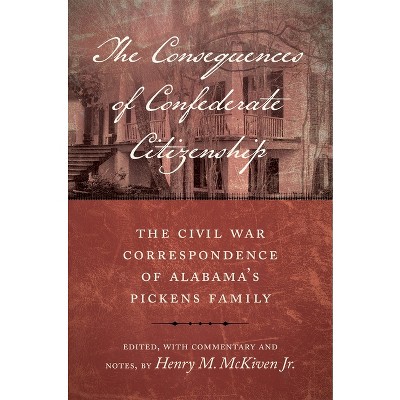Sponsored

Navigating Liberty - (Conflicting Worlds: New Dimensions of the American Civil War) by John Cimprich (Hardcover)
$45.49
In Stock
Eligible for registries and wish lists
Sponsored
About this item
Highlights
- Winner of the Phi Alpha Theta Best Subsequent Book Award When thousands of African Americans freed themselves from slavery during the American Civil War and launched the larger process of emancipation, hundreds of northern antislavery reformers traveled to the federally occupied South to assist them.
- About the Author: John Cimprich is retired professor of history at Thomas More University and author of Slavery's End in Tennessee, 1861-1865 and Fort Pillow, a Civil War Massacre, and Public Memory.
- 246 Pages
- History, United States
- Series Name: Conflicting Worlds: New Dimensions of the American Civil War
Description
About the Book
"As thousands of African Americans freed themselves from slavery during the American Civil War, they launched the major social change of emancipation. Hundreds of northern antislavery reformers responded by working with them in the federally occupied South. The formerly enslaved Black refugees generally could bring little or no property to help them build a free life but could contribute labor and skills. They maintained pressure for new privileges. The relief workers, especially when organized by aid associations and serving under military personnel charged with supervising the freedom seekers, could draw upon more resources and exert some influence on programs.The two groups brought views and practices from their backgrounds, which could help or trouble the transition out of slavery. Enslaved Blacks had learned to act with independent-mindedness and wariness when dealing with whites. They resented the northerners' preconceptions and attempts to control the transition, especially the use of force. Some disgruntled formerly enslaved Blacks even evaded or opposed programs created for them. Conflicts occasionally led to program modifications but frequently moved Blacks to seek more autonomy. Still, working together did result in some accomplishments. In an exhaustive analysis of that interaction, John Cimprich shows how the unusual circumstances opened new possibilities, spawned social movements for change, generated challenges, and produced limited results. His work is the first comprehensive study of the two groups' collaboration and conflict, adding an essential chapter to the history of slavery's end in the United States. Cimprich suggests that federal policy affected much of that interaction but that individuals' attitudes also played a key role. While Blacks saw themselves as equal humans, only a minority of white reformers shared that view. Over time, most Black refugees came to appreciate the reformers' idealism and charity while maintaining a degree of distance because of reformers' critical views. In the end, both groups' ongoing efforts to gain formerly enslaved Blacks new privileges ultimately led to social change. Cimprich's study is sure to be of interest to historians of slavery and the Civil War"--Book Synopsis
Winner of the Phi Alpha Theta Best Subsequent Book Award
When thousands of African Americans freed themselves from slavery during the American Civil War and launched the larger process of emancipation, hundreds of northern antislavery reformers traveled to the federally occupied South to assist them. The two groups brought views and practices from their backgrounds that both helped and hampered the transition out of slavery. While enslaved, many Blacks assumed a certain guarded demeanor when dealing with whites. In freedom, they resented northerners' paternalistic attitudes and preconceptions about race, leading some to oppose aid programs--included those related to education, vocational training, and religious and social activities--initiated by whites. Some interactions resulted in constructive cooperation and adjustments to curriculum, but the frequent disputes more often compelled Blacks to seek additional autonomy. In an exhaustive analysis of the relationship between the formerly enslaved and northern reformers, John Cimprich shows how the unusual circumstances of emancipation in wartime presented new opportunities and spawned social movements for change yet produced intractable challenges and limited results. Navigating Liberty serves as the first comprehensive study of the two groups' collaboration and conflict, adding an essential chapter to the history of slavery's end in the United States.Review Quotes
"Cimprich explores the complex interactions between freed African Americans and northern philanthropists in the South during the Civil War, sheding light on the fraught relationship between these two groups, as African Americans often harbored mistrust toward reformers due to their paternalistic policies and racist outlooks. . . . Cimprich offers a nuanced and detailed examination of northern reformers' and African Americans' wartime efforts to implement their conception of freedom. This book is a welcome addition to the study of slavery and the Civil War era."--Journal of Southern History
"Cimprich delivers a thoroughly explored and sensitively analyzed examination of the complicated interaction of southern African Americans emerging from slavery and northern philanthropists who attempted to assist them during the Civil War. His book details how freedpeople's lofty aspirations collided with well-intentioned but sometimes unenlightened visions that whites held about the postwar racial order."--John R. Kaufman-McKivigan, editor of The Frederick Douglass Papers and author of Forgotten Firebrand: James Redpath and the Making of Nineteenth-Century America
"John Cimprich has produced a deeply researched, sophisticated, and clearly written study of the relationship between white northern antislavery activists and freedom-seeking African Americans during the American Civil War. This book will be important to anyone interested in race relations, the Civil War era, and African American history."--Stanley Harrold, author of Subversives: Antislavery Community in Washington, D.C., 1828-1865
About the Author
John Cimprich is retired professor of history at Thomas More University and author of Slavery's End in Tennessee, 1861-1865 and Fort Pillow, a Civil War Massacre, and Public Memory.Dimensions (Overall): 9.0 Inches (H) x 6.0 Inches (W) x .69 Inches (D)
Weight: 1.16 Pounds
Suggested Age: 22 Years and Up
Number of Pages: 246
Series Title: Conflicting Worlds: New Dimensions of the American Civil War
Genre: History
Sub-Genre: United States
Publisher: LSU Press
Format: Hardcover
Author: John Cimprich
Language: English
Street Date: November 2, 2022
TCIN: 88967773
UPC: 9780807177990
Item Number (DPCI): 247-24-8415
Origin: Made in the USA or Imported
If the item details aren’t accurate or complete, we want to know about it.
Shipping details
Estimated ship dimensions: 0.69 inches length x 6 inches width x 9 inches height
Estimated ship weight: 1.16 pounds
We regret that this item cannot be shipped to PO Boxes.
This item cannot be shipped to the following locations: American Samoa (see also separate entry under AS), Guam (see also separate entry under GU), Northern Mariana Islands, Puerto Rico (see also separate entry under PR), United States Minor Outlying Islands, Virgin Islands, U.S., APO/FPO
Return details
This item can be returned to any Target store or Target.com.
This item must be returned within 90 days of the date it was purchased in store, shipped, delivered by a Shipt shopper, or made ready for pickup.
See the return policy for complete information.
Trending Non-Fiction

$19.31
was $20.98 New lower price
4 out of 5 stars with 65 ratings

$18.28
was $19.58 New lower price
4.7 out of 5 stars with 17 ratings

$4.59
MSRP $7.99
Buy 2, get 1 free select books
4.8 out of 5 stars with 123 ratings

$6.20
MSRP $10.95
Buy 2, get 1 free select books
4.8 out of 5 stars with 33 ratings

$7.09
MSRP $9.99
Buy 2, get 1 free select books
4.9 out of 5 stars with 46 ratings











